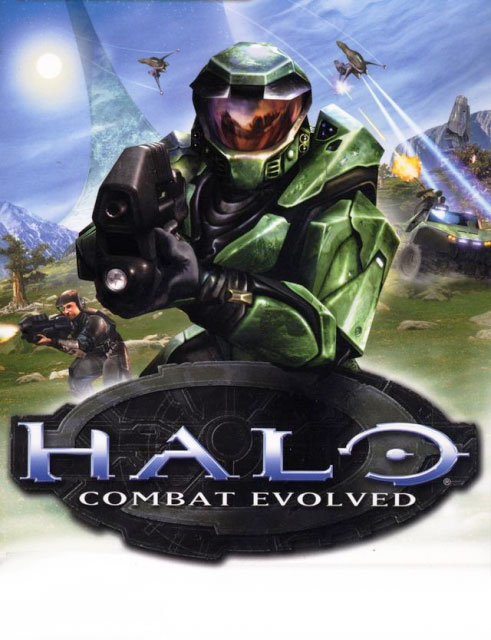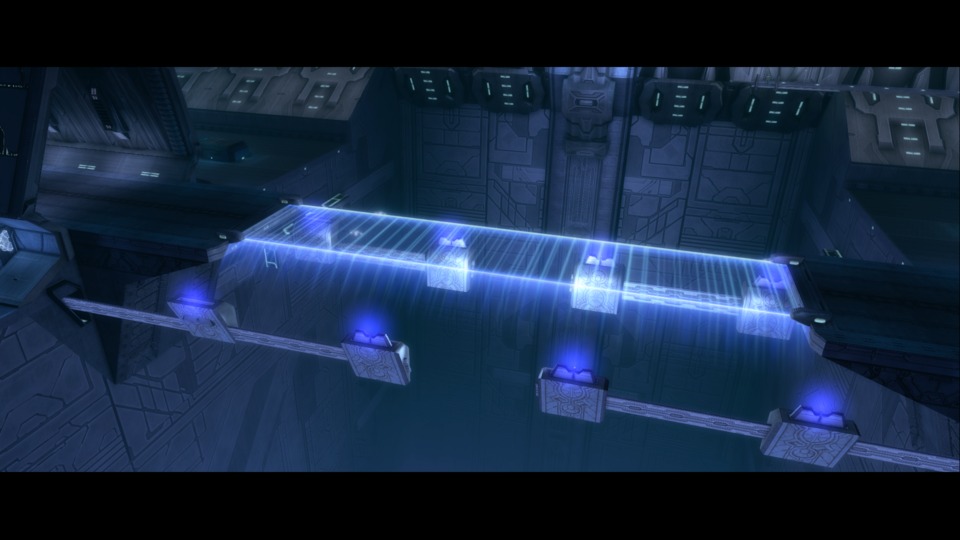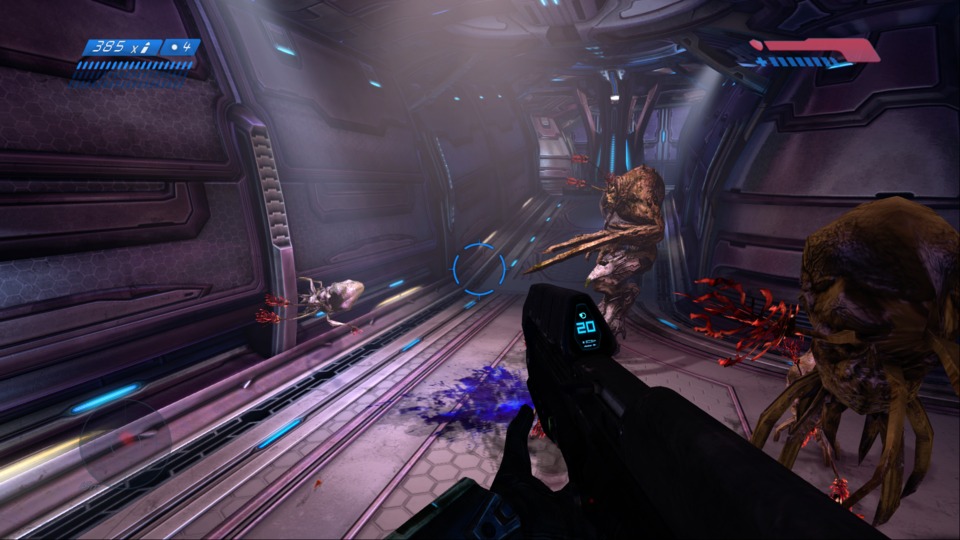The Great Journey Begins - Halo: Combat Evolved
By Darth_Navster 0 Comments

So my recent foray into Halo 5: Guardians has led me back down the deep dark rabbit hole that is the Halo franchise. In between rounds of slayer, I ordered a copy of The Master Chief Collection and am now seriously considering playing through all of the series campaigns again. I am of course a lapsed Halo fan, so while I considered this fool’s errand, I played through the entirety of Halo: Combat Evolved’s campaign. We’ll see how long this experiment lasts before I burn out, but for now, here are my thoughts on the OG Halo.
I fully admit that this is partly fueled by nostalgia, but upon booting up the first mission, I was enraptured with Halo’s presentation. Forgetting the remastered graphics, it truly is awe inspiring to be greeted with a somber orchestral arrangement as a spaceship crawls onto the screen in a very clear homage to Star Wars. From there is a mesmerizing pan into the command deck of the ship and you begin to realize the size that the game is hinting at. Not only does this opening impress on a surface level, it also establishes the dominant design criteria of the world; scale. Especially in the early going, Halo likes to emphasize the breadth of its various locations and uses contrasting scales to alter the way the game plays and looks.
The first mission has you, the Master Chief, running through the basics of how the game controls in the confines of the Pillar of Autumn. While the exterior of the ship is massive, you will only be able to play in a small part of it, full of winding corridors and open spaces with obstructions strewn about. The Chief feels big in this level, as there is barely any room to dodge plasma rounds or flank the enemy. This not only serves to encourage up close combat, but also to have the player get a good look at the Covenant enemies that they will face throughout the game. But the scale then changes once you get off the Autumn and land on the titular ringworld of Halo. Here you must rally human survivors in a massive open area. The Chief feels positively tiny here and requires the use of the 4-wheeled Warthog to get around at all. As you explore and save your fellow soldiers, you begin to get comfortable with fighting with allies, vehicle combat, and long range shooting. The pistol becomes invaluable to take out Covenant from a distance. The contrast between these two missions lays the template for the remaining missions to follow, with the changes happening more frequently to ensure that the player never gets too comfortable with a single strategy.

You can’t really talk about Halo without mentioning the famed combat triad: guns, melee, and grenades. By having each of these attacks mapped to separate buttons, Halo broke new ground by expecting players to use all three in tandem to take down the various enemies. Additionally, by limiting the weapons the Chief could carry to two, the player is constantly forced to improvise and to make the best use of non-ideal weapon loadouts. Combine that with the enemy variety and the seamless use of vehicles and you have the elements that make up Halo’s addictive combat sandbox. But for all the great design inherent in Halo’s systems, there are still missteps here and there. Primary among this is the non-regenerating health and weak shield that shows Bungie hedging their bet against the then prevailing shooter philosophy of health packs. It doesn’t necessarily break the game, but it does make it feel a bit more sluggish than its sequels, which for the most part ditch health packs for an entirely shield-based system. The other major error the game makes is the turn towards tedium in the campaign’s back half.
The introduction of the Flood in the sixth mission marks a distinct inflection point for Halo’s campaign. This isn’t necessarily because of the Flood themselves, as the horror movie introduction sets them up effectively and they remain interesting enemies to fight throughout the game. In fact, the sixth mission, otherwise known as 343 Guilty Spark, is actually one of the high points of the game. You begin the mission in an appropriately ominous swamp and are tasked with locating a missing marine squad. The abundance of trees and rolling terrain provides a great amount of cover, but the density of the swamp makes it easy for enemies to outflank you. It’s an interesting change of scale, where you are neither big nor small, just crowded. This sense of being crowded works quite well as a counterpoint to the building you enter at the level’s midpoint, which goes back to being tight and small. It also sets up the introduction of the Flood, who come bursting in a tight room just as soon as you discover the marine squad slaughtered by them. I still recall the utter panic I felt the first time I played this scene. Here was an enemy I had not seen before which was effectively immune to melee and resistant to plasma weapons. The game forces you to experiment with different tactics, relying more on human weapons and grenades to clear out the advancing horde. From there it seems that running is the best option to get back out to the relatively safe swamp. After fighting through the seemingly endless Flood in the building, you are greeted outside by friendly marines, but any relief is quickly washed away by even more Flood slaughtering your allies. When all seems lost, you finally meet the eponymous 343 Guilty Spark, an AI construct that seems to have the same goal as you; namely destroying the Flood. His armada of Sentinels, floating robots equipped with lasers, make short work of the remaining Flood and for the first time in the mission you start to feel a measure of safety to end the level. All in all, this is an excellently paced mission that uses its scale to ratchet and relieve tension in a masterful way. It is a shame, then, that the next few levels end up so disappointing.
Mission 7, better known as The Library, is probably one of the most infamous levels in the franchise. Here, you are charged to find and retrieve the Index, a sort of key that will activate Halo and eliminate the Flood. Unfortunately, to achieve this you will have to go through an arduous gauntlet of Flood that will ambush you in large numbers with lethal human weapons in a level with minimal variety throughout it. The remastered version of this level does improve the sameness of the environment with some fantastic art design, but it doesn’t fix the inherent problems with The Library. It is a frustrating mess of non-engaging combat in open spaces punctuated by cheap deaths by enemies with rocket launchers. It’s not all that bad, however. For one thing, this is the first time in the game that human weapons are in abundance which allows the player to truly experiment with the UNSC’s full arsenal. While you begin to really appreciate the assault rifle for being great at crowd control, the shotgun ends up being the star of the show. With the power and spread of the shotgun, you are able to take down multiple Flood in one shot and it puts you at a distinct advantage when the enemy gets in close to you. For the first time, you start to feel in control against the Flood, and the game smartly plays on the tension inherent in the limited ammo for the weapon. The times where shotgun ammo is scarce are when The Library begins to stress you out and makes it all the sweeter when you take down a shotgun wielding Flood to re-up your stash. Considering the length of the level and the constant ammo scavenging, Bungie clearly intended The Library to fit into the zombie horror genre, but it never quite pulls it off. But at least the mission attempts to achieve a vision, something that can’t be said for the next two levels.

Missions 8 and 9, named Two Betrayals and Keyes, respectively, really aren’t worth the effort to write about. Both are rehashes of previous missions in the campaign that had far better design and pacing. The missions aren’t complete lost causes, though, as you begin to see the Covenant and Flood fighting both the Chief and each other. Halo’s combat sandbox is fully realized here, as the player is able to manipulate both sides against each other for their benefit and experiment with the many permutations of enemies and weapons. Still, those brief moments are drowned out by the endless repeating corridors and unpredictable ambush points that will have the player restarting over and over. The checkpointing in these missions also seems suspect, as there were a few times where a checkpoint didn’t trigger which sent me back to old annoying combat encounters that I had already completed. It’s a shame too, as the story begins its climax with the AI Cortana determining the only way to stop the Flood and prevent Halo from wiping out all life is to detonate the now derelict Pillar of Autumn’s engines and destroy the ring world for good. Unfortunately you don’t get to do that until the final mission, The Maw.
The final mission at first glance doesn’t seem all that different from the abysmal missions that preceded it. It is a rehash of the campaign’s first level as you navigate the Pillar of Autumn, and there are a few frustrating points that result in cheap deaths. But what saves The Maw and allows the campaign to end on a high note is the final Warthog escape. The Chief and Cortana, having triggered the ship’s self-destruct sequence, frantically make their escape through the spine of the vessel using the iconic Warthog vehicle. This sequence acts as a culmination of the way the game plays with scale. You have several kilometers to go to reach a vessel to get you off Halo, so the run feels appropriate large and epic. Indeed, the enemies you whip past and/or run over feel miniscule compared to the explosions rocking the ship. But the path through the ship forces you through tight tunnels and turns that emphasize that the ship was never designed to allow you to drive through it. It isn’t necessarily a difficult sequence, but there are enough obstructions and enemies in your way to keep you focused on making your escape. The fake out in the middle of the run, where your pick-up transport is shot down and has you waste precious seconds, also helps make the entire escape feel tense and improvised. Even if you know it’s coming, I still recommend waiting to see Foe Hammer’s fiery death just to enhance the scene. From there, the Chief makes a final desperate run to a lone space fighter that gets him and Cortana out in the nick of time. An appropriately moody tune kicks in as our protagonist contemplates his journey, and credits.
So there you have it, Halo: Combat Evolved’s campaign. While not perfect, I found it to have held up remarkably well for the most part. The genesis of the modern console shooter began here, and it’s easy to see why. Halo is simply a mechanically brilliant game. The controls feel tight, the weapons are balanced well, and the enemies feel appropriately smart, but not to the point of frustration. The remaster is excellent and the implementation of the toggle between the old and new graphics is something I never grew tired of using. As I mentioned at the top, I may get burned out on this exercise, but for now I feel amped to jump into the Halo 2 remaster. We’ll see if it holds up as well as its predecessor.